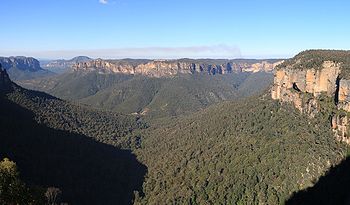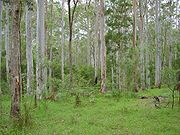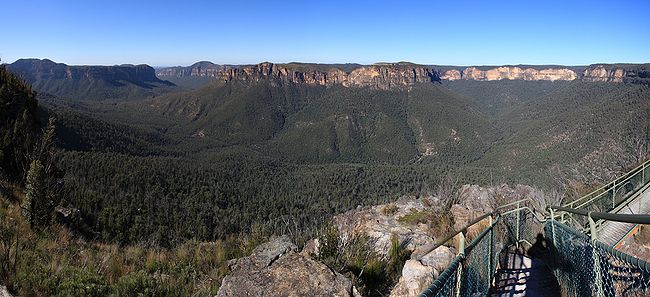
Grose River
Encyclopedia

New South Wales
New South Wales is a state of :Australia, located in the east of the country. It is bordered by Queensland, Victoria and South Australia to the north, south and west respectively. To the east, the state is bordered by the Tasman Sea, which forms part of the Pacific Ocean. New South Wales...
, Australia
Australia
Australia , officially the Commonwealth of Australia, is a country in the Southern Hemisphere comprising the mainland of the Australian continent, the island of Tasmania, and numerous smaller islands in the Indian and Pacific Oceans. It is the world's sixth-largest country by total area...
. It has been formed by the Grose River, the headwaters of which are in the Mount Victoria area. The valley is located between the two major routes across the Great Dividing Range
Great Dividing Range
The Great Dividing Range, or the Eastern Highlands, is Australia's most substantial mountain range and the third longest in the world. The range stretches more than 3,500 km from Dauan Island off the northeastern tip of Queensland, running the entire length of the eastern coastline through...
, the Great Western Highway
Great Western Highway
The Great Western Highway is a highway in New South Wales, Australia. It runs 210 km from Sydney to Bathurst.Starting as Broadway at the intersection of City Road near the fringe of the Sydney CBD, and becoming Parramatta Road to Parramatta itself, the Great Western Highway heads due west from...
and Bells Line of Road.
Description and history
The Grose River has cut a deep gorge through the area as it makes its way east towards the Hawkesbury RiverHawkesbury River
The Hawkesbury River, also known as Deerubbun, is one of the major rivers of the coastal region of New South Wales, Australia. The Hawkesbury River and its tributaries virtually encircle the metropolitan region of Sydney.-Geography:-Course:...
. Sheer sandstone
Sandstone
Sandstone is a sedimentary rock composed mainly of sand-sized minerals or rock grains.Most sandstone is composed of quartz and/or feldspar because these are the most common minerals in the Earth's crust. Like sand, sandstone may be any colour, but the most common colours are tan, brown, yellow,...
cliffs standing hundreds of metres above the river make for spectacular scenery and can be viewed extensively from the Blackheath area, where there are a number of accessible lookouts, the best known being Govetts Leap. The valley can also be viewed from lookouts near Bells Line of Road and points outside Mount Victoria.

Charles Darwin
Charles Robert Darwin FRS was an English naturalist. He established that all species of life have descended over time from common ancestry, and proposed the scientific theory that this branching pattern of evolution resulted from a process that he called natural selection.He published his theory...
described the Grose Valley as "stupendous … magnificent" when he visited in 1836
1836 in Australia
See also:1835 in Australia,other events of 1836,1837 in Australia and theTimeline of Australian history.-Governors:Governors of the Australian colonies:*Governor of New South Wales - Major-General Sir Richard Bourke...
. In 1859
1859 in Australia
See also:1858 in Australia,other events of 1859,1860 in Australia and theTimeline of Australian history.- Governors:Governors of the Australian colonies:*Governor of New South Wales — Sir William Denison*Governor of Queensland — Sir George Bowen...
some of the first photographs in Australia
Photography in Australia
The first photograph taken in Australia, a view of Bridge Street is believed to have been taken by a visiting naval captain, Captain Augustin Lucas in 1841, as indicated by a note published in the Australasian Chronicle for 13 April of that year...
were taken in the valley. At various times there were proposals for rail lines and dams but these have not proceeded. In 1931
1931 in Australia
See also:1930 in Australia,other events of 1931,1932 in Australia and theTimeline of Australian history.-Incumbents:*Monarch – King George V*Governor-General – John Baird, 1st Viscount Stonehaven , then Sir Isaac Isaacs...
, the valley was the subject of one of Australia's first forest conservation battles.
Within the valley, the Blue Gum Forest is one place that stands out from the rest of the valley. It consists predominantly of towering Blue Gum
Blue Gum
Blue Gum usually refers to the subspecies or the species in Eucalyptus globulus complex, however it may also refer to a number of other species of Eucalyptus in Australia. Confusingly, in Queensland it usually refers to Eucalyptus tereticornis, which is known elsewhere as Forest Red Gum.* Gippsland...
trees (Eucalyptus deanei, also known as Deane's Gums, or Broad-leafed gums), with a thin understorey because the tall trees inhibit the growth of ground cover by blocking most of the sunlight.
Protected by the Blue Mountains National Park
Blue Mountains National Park
The Blue Mountains National Park is a national park in New South Wales, Australia, 81 km west of Sydney, and located in the Blue Mountains region of the Great Dividing Range. The park covers 268,987 hectares. The boundary of the park is quite irregular as it is broken up by roads, urban areas...
, the forest can be accessed only on foot, with several trails from different parts of the Grose Valley and adjacent canyons meeting in the forest.
There are a number of walks through the valley, with various entry, exit points and valley arms offering a range of permutations to explore. A moderate-grade day walk covering approximately 10 km in five hours starts at Perrys Lookdown and descends sharply to the valley floor. Crossing through a corner of the Blue Gum Forest, the track goes south through the Acacia Flat camp ground, following the Govetts Creek. Passing several abandoned campgrounds, the path forks at Junction Rock; the route to Govetts Leap was closed in October 2003, following a landslide, and was reopened in December 2007. In the other direction, along Govetts Creek, the route then starts a continuous climb towards the Grand Canyon, where it forks again; one track goes to Neates Glen, while the other is a steep climb to Evans Lookout. The general direction of travel is towards the southeast and this direction is recommended as the final climb at Evans Lookout is not as difficult as the ascent at Perrys Lookdown. Creeks in the valley are seasonal and highly polluted, and are known to cause gastrointestinal upsets. The walk is much more strenuous in summer due to the higher daily temperatures and there is also an attendant greater risk from bushfire.
The valley has been affected by bushfires at various times, notably in 1982 and in November 2006. In particular the Blue Gum Forest was damaged by back burning. Owing to the harsh bushfires in 2006, the Blue Gum forest and other walking tracks in the valley were closed to bushwalkers to allow the regrowth of vegetation. As of March 2009, all tracks in the Grose Valley are open, with the exception of the Rodriguez Pass into the valley from Evans lookout and the Grand Canyon, closed due to a landslide. The entrance to the Grand Canyon via Neates Glen will not be available on weekdays from late march to the end of 2009 due to remediation work on the track.
The Grose Valley arguably became the cradle of the modern conservation movement in NSW when Blue Gum Forest was saved from threatened destruction in 1931-32. A group from the Sydney Bush Walkers club, led by Alan Rigby, were camped in the forest when they chanced upon a Bilpin farmer, Clarrie Hungerford. Hungerford had a lease of the forest and told the bushwalkers he planned to clear the blue gums to plant walnuts. The bushwalkers went away and started a campaign to stop him. Eventually, they raised 130 pounds which they paid Hungerford in exchange for his relinquishing the lease. It was a substantial amount at the height of the great depression. 80 pounds came in the form of an interest-free loan from James Cleary, then head of the NSW railways and subsequently chairman of the Australian Broadcasting Commission. Cleary was also a bushwalker.
One of the key activists in the campaign was Myles Dunphy, who at the time was developing his plans for the Blue Mountains National Park.
The valley's human history is far older than the above events. Firstly, it was home to Aboriginal people; their artefacts have been found close to the forest. During the 1800s there were various proposals to dam the Grose Valley, and one such dam would have been at the forest. The area was also the subject of a number of proposed coal and shale mining ventures, and in the 1850s it was planned that the main western railway line would be routed up the Grose River and through the forest.
In 1875 Blue Gum Forest was the scene of an artists’ camp established by Eccleston Du Faur, of the Academy of Art. Several magnificent photographs by Alex Bischoff and drawings and paintings by William Piguenit resulted. Another outcome was that the whole Grose Valley and surrounds was reserved from alienation because it was ‘a national spectacle’. At the time there was no national park in Australia, and indeed Australia was not even a nation—but the reservation in essence was the country’s first national park.

Major tracks
- Neates Glen to Evans Lookout
- Rodriguez Pass to Govetts Creek
- Govetts Leap to Junction Rock
- Junction Rock to Blue Gum Forest
- Blue Gum Forest to Perrys Lookdown
- Blue Gum Forest to Burra Korain Flat
- Burra Korain Flat to Victoria Falls Lookout
- Govetts Leap to Evans Lookout
- Lockley Track from Blue Gum Forest to Mount Hay Road
- Mount Hay Track
Major lookouts
- Govetts Leap
- Evans Lookout
- Point Pilcher
- Perrys Lookdown
- Anvil Rock
- Baltzer Lookout
- Walls Lookout
- Victoria Falls Lookout
- Lockley Pylon
- Mount Banks

